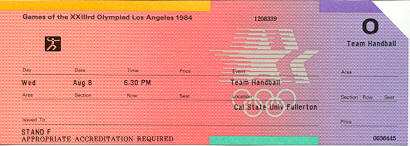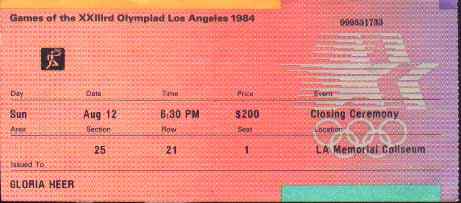Tickets
| Overview of ticket printing 1984
The LAOOC developed a unique system for processing orders which represented a departure from the prevailing practice of producing preprinted physical tickets whereby each individual order had to be filled by tedious and error-prone manual methods. The new approach, for the first time, combined modern computer technology with the latest developments in printing technology. The result was the printing of custom tickets for each order. Ticket printing involved the following steps:
The remarkable feature of the LAOOC's ticket printing system was the ability to print customized tickets. After receipt of the raw, unprinted ticket stock, the computerized ticket printing machinery read information off of the print tape which allowed it to imprint the raw stock with the appropriate sport pictogram, session, day, date and time, price, event, location and seat assignment. For tickets ordered by mail, the tape also provided the purchaser's name which was imprinted in the lower left hand corner of each ticket. The print tapes allowed printing of eight tickets at a time, each of which was part of a different order. Thus, the orders of eight persons who had each purchased ten tickets were printed simultaneously on ten sheets of eightticket stock. The ten sheets were then cut to form the ticket package for each person. This ten-sheet print process was much faster than the conventional method of printing the 80 tickets involved individually. The largest problem in the printing process was related to the receipt of print tapes from the computer center. The ticketing computer system, because of the complex sorting requirement of the print process, could not always create print tapes in advance of the completion of printing the prior tapes. This resulted in a start/ stop type of print operation while waiting for more tapes to be produced. Another problem inherent in the printing operation concerned the possibility of printing duplicate tickets. This could occur whenever it was necessary to restart the machine following a stoppage. Stoppages were fairly frequent because of paper jams or other causes. Extreme vigilance was necessary to detect the printing of duplicate tickets. In several instances duplicate tickets were discovered during the final audit process. The final phase of the process required the application of registered mail labels to the ticket envelopes for delivery through the United States Postal Service. This process required large amounts of manpower and could not be mechanized.
Ticket design Tickets for prior Games were preprinted in advance of sale and normally included a different ticket stock for each sport or venue. Since the LAOOC's ticket system printed tickets to customer order, separate ticket stock for each sport could not be produced. Consequently, with the exception of the Opening Ceremonies ticket, all ticket stock printed through the main system was the same. Variable data was printed for each individual order and included sport, date, time, venue, seat location, customer name, customer order number, sport pictogram and event code. The ticket design included a festive rainbow tint to coordinate with the overall Look of the Games. Security features included a watermark imbedded in the ticket stock and a recently developed ink which disappeared when heat was applied. The color would disappear and then return to its normal state when the heat was removed. The latter anti-counterfeiting feature was significant since the ink was new on the market and had not been used commercially in the United States prior to the 1984 Olympic Games. Tickets were bound in a binder which was color coordinated with the tickets. Separate ticket stock was designed for over-the-counter sales of football tickets for matches held at sites outside of Los Angeles. These tickets contained minimal security features since the LAOOC did not believe there was any economic benefit to the counterfeiting of these tickets. A third stock was used for Southern California Ticket and Information Center sales. The primary security feature contained in these tickets was metallic lettering which could not be copied by colorreproducing photocopiers presently on the market. (Source document: Official Report 1984, Vol. 1, page 802) |

